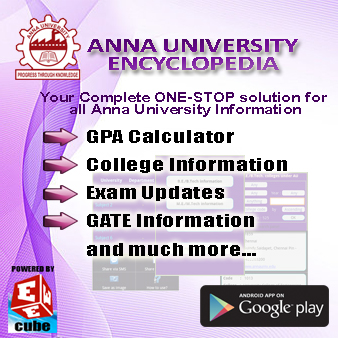SUBJECT RESOURCES:
CLICK HERE to access 'Previous Year question papers'
CLICK HERE to access '2 Marks with answers'
CLICK HERE to access 'Lecture Notes'
CLICK HERE to access search more about this subject
CLICK HERE to make a request for any study material.
SYLLABUS:
CLICK HERE to access 'Previous Year question papers'
CLICK HERE to access '2 Marks with answers'
CLICK HERE to access 'Lecture Notes'
CLICK HERE to access search more about this subject
CLICK HERE to make a request for any study material.
SYLLABUS:
CS2411 OPERATING SYSTEMS
L T P C
3 0 0 3
Aim:
To learn the various aspects
of operating systems such as process management, memory
management, file systems, and I/O management
UNIT I PROCESSES AND THREADS 9
Introduction to operating systems – review of computer organization – operating system structures –
system calls – system programs – system structure – virtual machines. Processes: Process concept
– Process scheduling – Operations on processes – Cooperating processes – Interprocess communication – Communication in client-server
systems. Case study: IPC in Linux. Threads: Multi-
threading models – Threading issues. Case Study: Pthreads library
UNIT II PROCESS SCHEDULING AND SYNCHRONIZATION 10
CPU Scheduling: Scheduling criteria – Scheduling algorithms – Multiple-processor scheduling –
Real time scheduling – Algorithm
Evaluation. Case study: Process scheduling in Linux. Process
Synchronization: The
critical-section problem –
Synchronization hardware –
Semaphores – Classic problems of synchronization – critical regions – Monitors. Deadlock: System
model – Deadlock characterization – Methods for handling deadlocks – Deadlock prevention – Deadlock avoidance –
Deadlock detection – Recovery from
deadlock.
UNIT III STORAGE MANAGEMENT 9
Memory Management: Background – Swapping – Contiguous memory allocation – Paging
– Segmentation – Segmentation with paging. Virtual Memory:Background – Demand paging – Process
creation – Page replacement –Allocation of frames – Thrashing. Case Study: Memory management
in
Linux
UNIT IV FILE SYSTEMS 9
File-System Interface: File concept – Access methods – Directory structure
–File-system mounting
– Protection. File-System
Implementation : Directory implementation – Allocation methods – Free-
space management – efficiency and performance – recovery – log-structured file systems. Case
studies: File system
in Linux – file system in Windows XP
,
UNIT V I/O SYSTEMS 8
I/O Systems – I/O Hardware
– Application I/O interface –
kernel I/O subsystem – streams –
performance. Mass-Storage Structure:
Disk scheduling
–
Disk management
–
Swap-space
management – RAID – disk attachment – stable storage – tertiary storage. Case study: I/O in Linux
TOTAL : 45 PERIODS
TEXT BOOKS
1. Silberschatz, Galvin, and Gagne, “Operating System Concepts”, Sixth Edition, Wiley India Pvt
Ltd, 2003.
2. D. M. Dhamdhere, “Operating Systems: A concepts based approach”, Second Edition, Tata
McGraw-Hill
Publishing Company Ltd., 2006.
REFERENCES
1. Andrew S. Tanenbaum, “Modern Operating Systems”, Second Edition, Pearson
Education/PHI, 2001.
2. Harvey M. Deital, “Operating Systems”, Third Edition, Pearson Education, 2004.
|
|










No comments:
Post a Comment
Note: Only a member of this blog may post a comment.